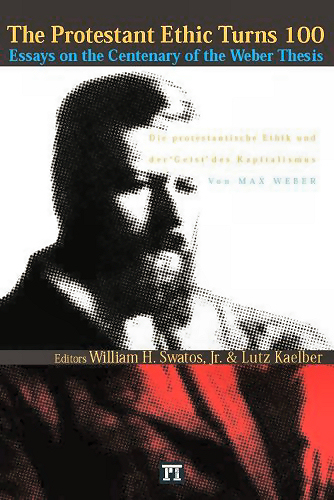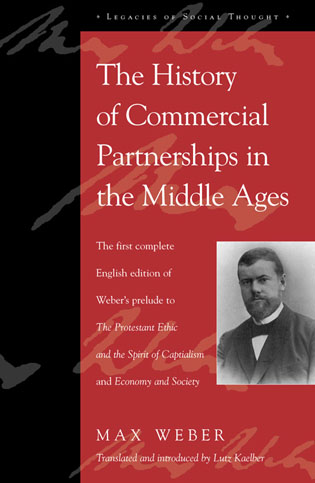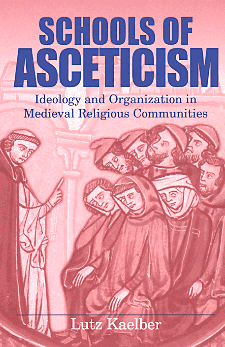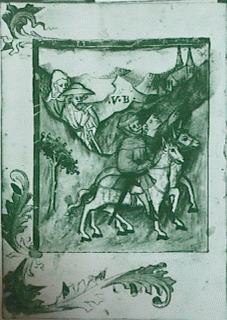

The years 2004-2005 mark the centenary of the original Protestant Ethic essays. Bill Swatos and I edited a collection of essays addressing the essays original context, historical reception, and ongoing relevance (Paradigm Publishers, 2005). The contributors include Philip Gorski, Stephen Kalberg, Peter Kivisto, Hartmut Lehmann, Donald Nielsen, Martin Riesebrodt, and Lawrence Scaff. My contributions are the Introduction as well as a chapter entitled “Rational Capitalism, Traditionalism, and Adventure Capitalism: New Research on the Weber Thesis.”
This CHOICE review provides a brief glimpse of its contents:
The Protestant Ethic and the Spirit of Capitalism (PESC) is Max Weber's controversial, multilayered work, consistently ranked as one of the most influential sociological texts ever written. The collective scholarship of this edited volume provides a grand overview of the history, assessment, and implications from a century of reflection on his text. The essays are fresh and interesting, and readily encourage an enlightened, contextual reading of Weber. They affirm the validity of the Weber thesis in supporting a causal connection between ascetic Protestantism emerging from the Reformation and the development of modern rational capitalism—although with many clarifications, several caveats, and one alternative narrative connecting the Reformation to capitalism in Europe. Several essays introduce little-known aspects of Weber's life and scholarship, especially the influence of his 1904 travels in the US. Recommended along with Fritz Ringer's Max Weber: An Intellectual Biography and editor Charles Camic et al.'s Max Weber's Economy and Society: A Critical Companion (2005), this collection reveals the immense sophistication of Weber's work, however incomplete and fragmentary it remains. In addition, while exploring the history of PESC, readers gain an important education in the development of 20th-century sociology in the US. Summing Up: Highly recommended. All levels/libraries.—G. Marti, Davidson College

In 2003, I published a translation of Max Weber's dissertation and first book, entitled The History of Commercial Partnerships in the Middle Ages. For more information about Weber's dissertation, go here. For more information about his personal life, go here.
I have revisited the issue of usury in Weber's work, which received its most extensive (and previously not acknowledged) treatment in this book, in “Max Weber on Usury and Medieval Capitalism: From The History of Commercial Partnerships to The Protestant Ethic” (Max Weber Studies 4 [2004]: 51-75).
Reviews of The History of Commercial Partnerships have appeared in the following journals:
See also: “At Long Last, Dissertations by Max Weber and Jacques Derrida Are Published in English.” “Hot type” Column in Chronicle of Higher Education 49, 30 (2003): A14.
A list of errata/changes to the translation can be found here.
Max Weber's Protestant Ethic continues to be an influential work in sociology and other social sciences. The 1919-20 German version is part of the Potsdamer Internet-Ausgabe of his writings. A recent English translation by Stephen Kalberg complements the older translation by Talcott Parsons. I have discussed the strengths and weaknesses of Kalberg's (2001) translation in "Max Weber's Protestant Ethic in the 21st Century" (International Journal of Politics, Culture, and Society 16 [2002]: 133-46; see also my response to his reply in ibid., 17 (2003): 331-32). My review of Jere Cohen's book, Protestantism and Capitalism: The Mechanisms of Influence (deGruyter, 2002), which provides a new reflection on an old topic, was published in the Canadian Journal of Sociology (28 [2003]: 575-81).
Weber's thinking in the Protestant Ethic, as well as in his dissertation, in Economy and Society, and in other writings was influenced by Weber's status as what Guenther Roth has called scion of the cosmopolitan bourgeoisie. For my review essay on Roth's magnum opus of Weber's family history, Max Webers deutsch-englische Familiengeschichte 1800-1950. Mit Briefen und Dokumenten (Tübingen: Mohr, 2001), entitled “How Well Do We Know Max Weber After All? A New Look at Max Weber and His Anglo-German Family Connections” (International Journal of Politics, Culture, and Society 17 [2003]: 307-27), go here.

In graduate school I became interested in Max Weber's Protestant Ethic thesis, which led me to explore precursors to inner-worldly asceticism in medieval religious groups. I studied orthodox monastic and lay groups, but what interested me most were medieval heretical groups, such as the Waldensians and the Cathars. Out of this interest developed what ultimately turned into a book, Schools of Asceticism: Ideology and Organization in Medieval Religious Communities (University Park, PA: Penn State Press, 1998). It explores how religious ethics (doctrines and other elements of belief structures) and organizational arrangements of religious communities interacted to shape their members' conduct, or how they acted in everyday life. Social class and gender are part of the analysis. The book received the Best Book Award of the Sociology of Religion Section of the American Sociological Association in 1999.
For an updated version on the chapter on the Cathars, see my article “Sociological Explanations of Cathar Success and Tenacity in Languedoc: A New Perspective Focusing on the ‘Houses of Heretics.’” Heresis: Revue semestrielle d’histoire des dissidences médiévales 38 (2003): 31-49.
For a more extensive look at monasticism, see my contribution “Monasticism: Christian Monasticism,” pp. 6131-36 in The Encyclopedia of Religion, 2nd ed., vol. 9, edited by Lindsay Jones (New York: Macmillan, 2005), and for a short overview of Waldensianism, “Waldensians,” in Encyclopedia of Religious Freedom, edited by Catharine Cookson (New York: Routledge, 2003: 507-8).Schools of Asceticism was reviewed in the
following journals:

Pilgrims traversing an Alpine landscape (15th-century prayer book) |
More
recently I have turned to the sociology of
pilgrimage and tourism, and what can be described as increasingly
fuzzy
and diaphanous boundaries between the two types of travel. While
at
first sight it may seem that pilgrimage-commonly referred to as
religiously motivated travel to a sacred place or person-and
tourism-recreationally motivated travel to a place that offers
regeneration or is of cultural interest-historically did
not mix, forms of travel that in some ways combined the two
go
back to western antiquity and the Middle Ages. For example, some
female
medieval mystics used pilgrimage travel to transcend the rigid
gender
boundaries of the time and to educate themselves while on the
road, and
professional pilgrims undertook pilgrimages-by-proxy, by which
they
combined travel for the sake of another person's spiritual welfare
with
personal entertainment.
Much more recent is the phenomenon of travel to what George Ritzer has called "cathedrals of consumption," perhaps part of the experience of postmodernity. As scholars have argued, when eliciting feelings of awe and the quasi-veneration of consumptive practices, these cathedrals may represent the equivalent of the pilgrimage centers of old. Other examples of a cultic consumption of sacred spaces include tourism to national shrines such as Graceland and to theme parks (e.g., Disney World). A related topic is virtual pilgrimage. For a preliminary
exploration of some of the issues mentioned above, see “The
Sociology
of Medieval Pilgrimage: Contested Views and Shifting
Boundaries.” Pp. 51-74 in From Medieval Pilgrimage to
Religious Tourism: The Social and Cultural Economics of Piety,
edited by William H. Swatos, Jr., and Luigi Tomasi. |